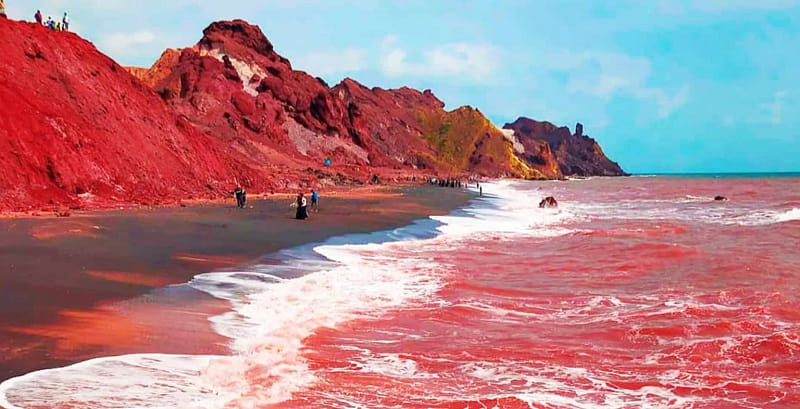
Hormuz island
Hormuz Island , also spelled Hormoz, is an Iranian island in the Persian Gulf. Located in the Strait of Hormuz, 8 km (5 mi) off the Iranian coast, the island is part of Hormozgan Province. It is sparsely inhabited, but some development has taken place since the late 20th century.
History
The earliest evidence for human presence on the island is several stone artifacts discovered at the eastern shorelines of the island. A lithic scatter was found at a site called Chand-Derakht, which is an uplifted marine Pleistocene terrace. This site yielded a Middle Paleolithic lithic assemblage characterized by Levallois methods and dates back to more than 40,000 years ago.
The island, known as Organa (Όργανα) to the ancient Greeks and as Jarun in the Islamic period, acquired the name of "Hormuz" from the important harbour town of Hormuz (Ormus) on the mainland 60 km away, which had been a centre of a minor principality on both sides of the strait. The principality paid tribute to the Mongol-ruled Ilkhanate and was an important source of income from maritime trade. The town's ruler decided to shift his residence to the island around 1300, in order to evade attacks by Mongolian and Turkish groups from the interior. The ruler later made peace with the Ilkhans.
A new town was built on the northern tip of Jarun island which was called New Hormuz for a number of years to distinguish it from the old town on the mainland until this fell into ruins. Slowly the name of the new town came to be used for the island as well.
The island is arid, and during the summer months, the temperature can rise to over 43 °C (109 °F). As such, it was not an ideal location for the capital of a principality as all provisions including water had to be brought from the mainland. Its location, however, gave the island a degree of security which let it grow to be a major trading port for several centuries. As its competitors suffered from intermittent destruction, Hormuz remained a reliable and relatively safe harborage.
Hormuz was visited by Marco Polo, around 1290, while traveling by land, as described in his travelogue.
Ibn Battuta also visited the island and New Hormuz.
Portuguese presence in the Persian Gulf and Red Sea. Green – Portuguese possessions. Dark green – allied or under influence.
In 1505, King Manuel I of Portugal established a policy of expansion in Africa and Western Asia. During attempts to expand Portuguese influence into the Indian Ocean, the Portuguese duke Afonso de Albuquerque captured the island in 1507 and it was incorporated into the greater Portuguese Empire. The Portuguese constructed a fortress on the island to deter potential invaders, naming it the Fort of Our Lady of the Conception. The island became an emergency stopover point for Portuguese ships traveling to Goa, Gujarat, and nearby Kishm. The Ottomans laid siege to the island under the admiral and cartographer Piri Reis in 1552. In 1622, the island was captured from the Portuguese by a combined Anglo-Persian force at the behest of the English East India Company.
Shah Abbas I of Persia distrusted the local population and was not interested in maintaining the island as a trading centre or military post; instead he developed the nearby mainland port of Bandar Abbas. Hormuz went into decline. Many of its inhabitants seasonally moved to their fields and orchards around the old Hormuz on the mainland, only fishermen being in permanent residence. The island continued to export small quantities of rock salt and lumps of iron oxide which were used as ballast stones for sailing ships.
After a period of Omani administration in the 19th century, it remained a sparsely inhabited fishermen's island before experiencing some development in the later years of the 20th century.


